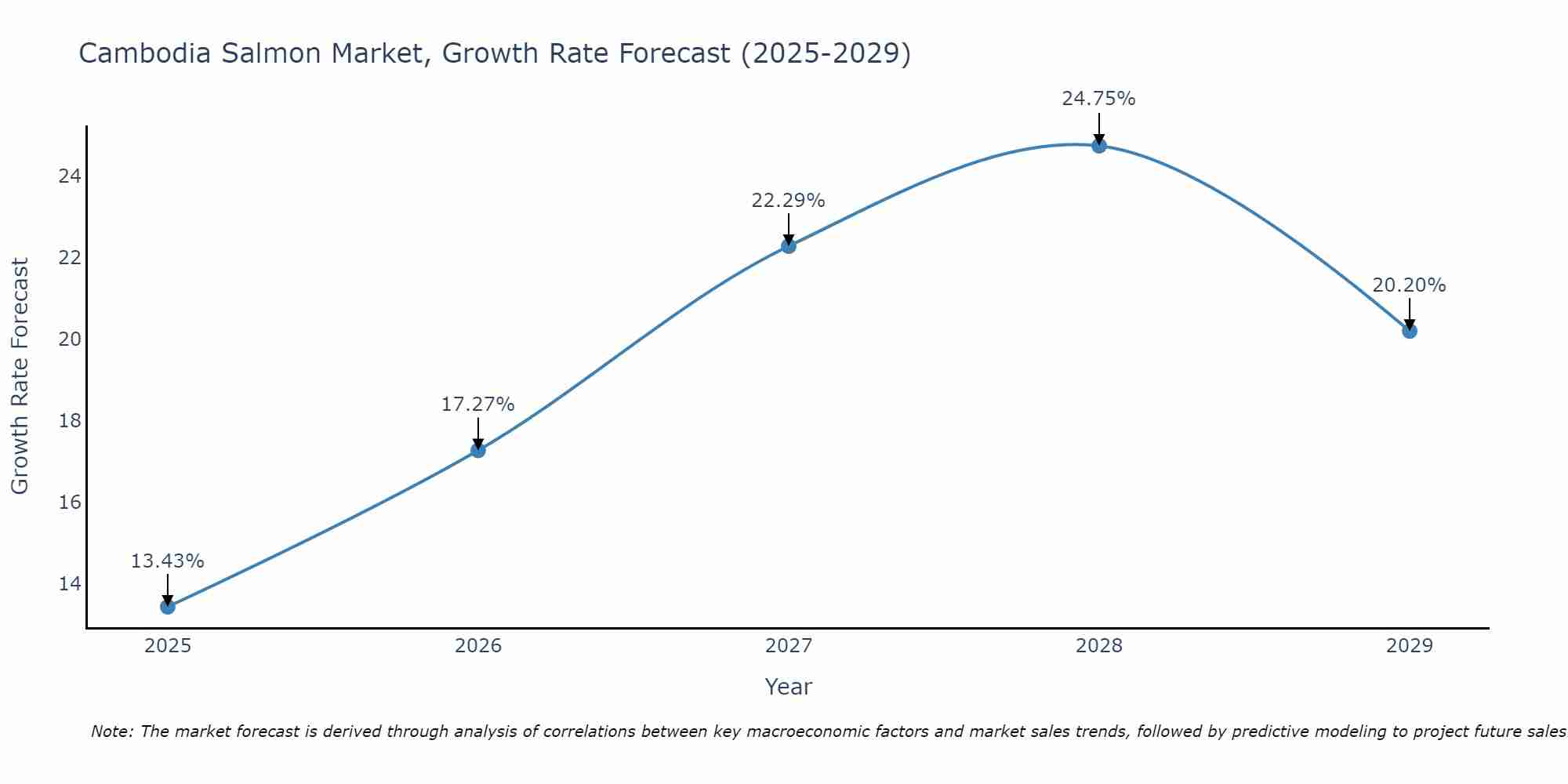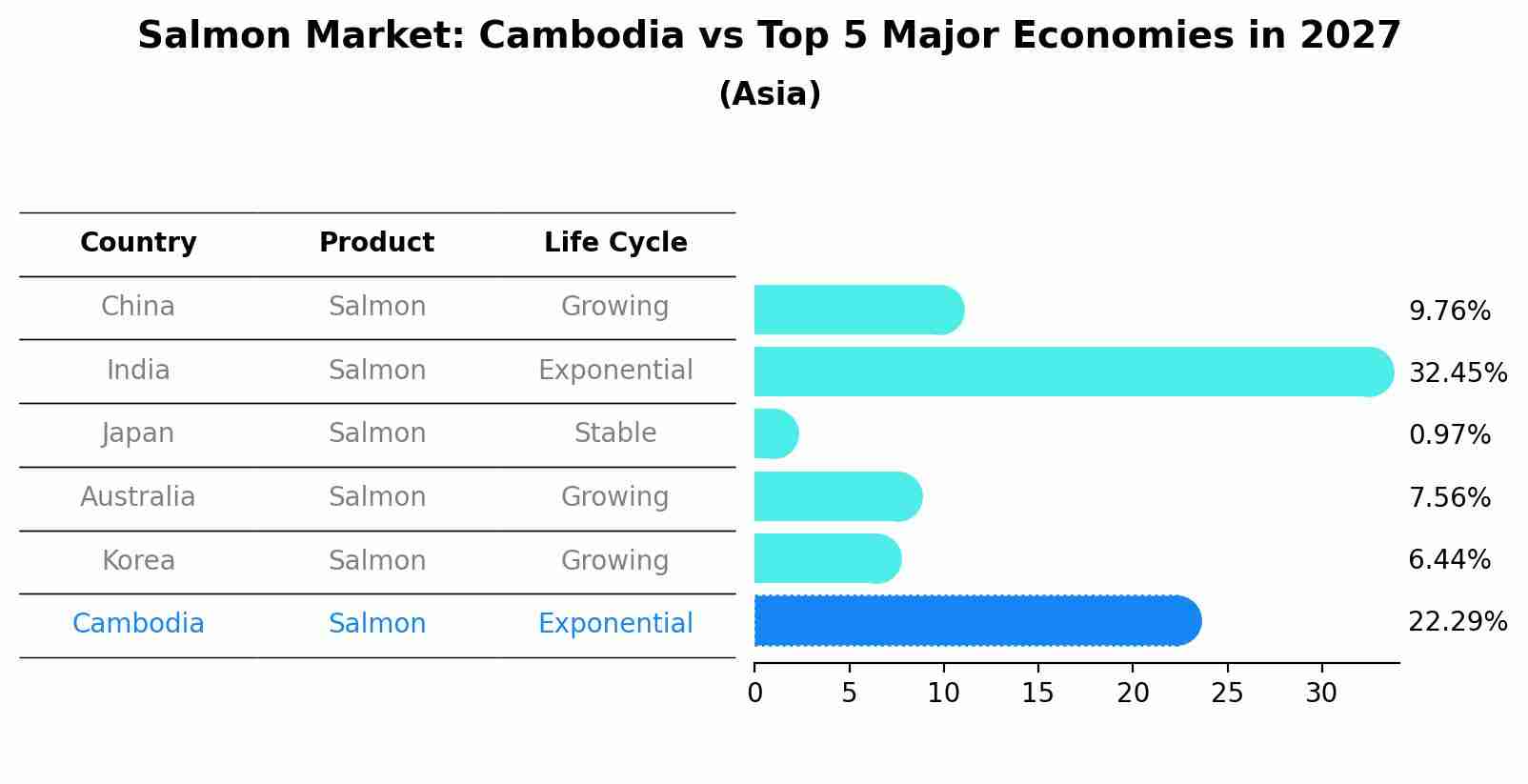Cambodia Salmon Market (2025-2031) Outlook | Trends, Analysis, Value, Size, Industry, Companies, Forecast, Share, Growth, Revenue
| Product Code: ETC387633 | Publication Date: Aug 2022 | Updated Date: Jul 2025 | Product Type: Market Research Report | |
| Publisher: 6Wresearch | Author: Ravi Bhandari | No. of Pages: 75 | No. of Figures: 35 | No. of Tables: 20 |
Cambodia Salmon Market Size Growth Rate
The Cambodia Salmon Market is projected to witness mixed growth rate patterns during 2025 to 2029. Growth accelerates to 24.75% in 2028, following an initial rate of 13.43%, before easing to 20.20% at the end of the period.

Salmon Market: Cambodia vs Top 5 Major Economies in 2027 (Asia)
The Salmon market in Cambodia is projected to grow at a exponential growth rate of 22.29% by 2027, within the Asia region led by China, along with other countries like India, Japan, Australia and South Korea, collectively shaping a dynamic and evolving market environment driven by innovation and increasing adoption of emerging technologies.

Cambodia Salmon Market Synopsis
The Cambodia Salmon Market is a niche segment within the seafood industry, primarily catering to high-end restaurants and hotels in urban areas. Imported mainly from countries like Norway and Chile, salmon is considered a premium product in Cambodia due to its perceived health benefits and unique taste. The market is relatively small compared to other seafood products but is steadily growing in popularity among the middle and upper-class consumers. However, challenges such as high import costs, limited awareness among the general population, and competition from local seafood options hinder the market`s potential for mass adoption. Overall, the Cambodia Salmon Market presents opportunities for premium seafood suppliers to target affluent consumers seeking international gourmet experiences.
Cambodia Salmon Market Trends
The Cambodia Salmon Market is experiencing a growing trend towards increased consumption of salmon due to rising health consciousness and a growing demand for high-quality seafood products. Consumers are becoming more aware of the health benefits associated with salmon, such as being a good source of omega-3 fatty acids and high-quality protein. As a result, there is a rising interest in incorporating salmon into Cambodian cuisine and diets. Furthermore, the availability of imported salmon in supermarkets and restaurants has also contributed to the increasing popularity of this fish among Cambodian consumers. Overall, the Cambodia Salmon Market is witnessing a trend of shifting consumer preferences towards healthier and premium seafood options, particularly salmon.
Cambodia Salmon Market Challenges
The Cambodia Salmon Market faces several challenges primarily due to the lack of local production and limited access to fresh salmon imports. As a landlocked country, Cambodia heavily relies on imported seafood, including salmon, which can lead to issues related to transportation logistics, quality control, and pricing fluctuations. Additionally, the high cost of imported salmon makes it less affordable for the average Cambodian consumer, limiting the market potential. Moreover, there may be concerns regarding the sustainability and environmental impact of salmon farming practices, which could further hinder market growth. Overall, the Cambodia Salmon Market struggles with supply chain challenges, affordability issues, and sustainability considerations, which collectively impact the market`s accessibility and development within the country.
Cambodia Salmon Market Investment Opportunities
Investment opportunities in the Cambodia Salmon Market are emerging due to the increasing demand for high-quality seafood in the country. As Cambodia`s economy grows and consumer preferences shift towards healthier and premium food options, there is a growing market for salmon products. Investors can consider opportunities in salmon importation and distribution, establishing salmon-focused restaurants or retail outlets, or even investing in aquaculture projects to produce salmon locally. Partnering with established seafood suppliers or leveraging e-commerce platforms can help investors tap into this niche market. However, it is important to conduct thorough market research, understand the regulatory environment, and assess the competition to make informed investment decisions in the Cambodia Salmon Market.
Jordan Agar Market Government Policies
The Cambodian government has implemented policies to support the growth of the salmon market in the country. This includes initiatives to improve fish farming practices, increase production capacity, and enhance the quality and safety standards of salmon products. Additionally, the government has provided support for research and development in the aquaculture sector to promote sustainable farming methods and enhance the competitiveness of Cambodian salmon in the global market. Furthermore, there are efforts to strengthen regulatory frameworks to ensure compliance with food safety standards and promote consumer confidence in locally produced salmon. Overall, these policies aim to drive the growth of the Cambodia salmon market and position the country as a key player in the aquaculture industry.
Cambodia Salmon Market Future Outlook
The future outlook for the Cambodia Salmon Market appears promising, driven by a growing consumer demand for healthy and premium seafood products. As the country`s economy continues to develop, there is an increasing interest in diversifying the seafood offerings, with salmon being a popular choice among the affluent and health-conscious population. Additionally, the rising trend of international cuisine and dining out experiences in Cambodia is expected to further boost the demand for salmon products in restaurants and supermarkets. However, challenges such as logistics and infrastructure limitations may impact the market growth. Overall, with the right marketing strategies and distribution channels, the Cambodia Salmon Market is poised for steady growth in the coming years.
Key Highlights of the Report:
- Cambodia Salmon Market Outlook
- Market Size of Cambodia Salmon Market, 2024
- Forecast of Cambodia Salmon Market, 2031
- Historical Data and Forecast of Cambodia Salmon Revenues & Volume for the Period 2021 - 2031
- Cambodia Salmon Market Trend Evolution
- Cambodia Salmon Market Drivers and Challenges
- Cambodia Salmon Price Trends
- Cambodia Salmon Porter's Five Forces
- Cambodia Salmon Industry Life Cycle
- Historical Data and Forecast of Cambodia Salmon Market Revenues & Volume By Type for the Period 2021 - 2031
- Historical Data and Forecast of Cambodia Salmon Market Revenues & Volume By Chinook Salmon for the Period 2021 - 2031
- Historical Data and Forecast of Cambodia Salmon Market Revenues & Volume By Coho Salmon for the Period 2021 - 2031
- Historical Data and Forecast of Cambodia Salmon Market Revenues & Volume By Pink Salmon for the Period 2021 - 2031
- Historical Data and Forecast of Cambodia Salmon Market Revenues & Volume By Red Salmon for the Period 2021 - 2031
- Historical Data and Forecast of Cambodia Salmon Market Revenues & Volume By Salmo Salar for the Period 2021 - 2031
- Historical Data and Forecast of Cambodia Salmon Market Revenues & Volume By Silverbrite Salmon for the Period 2021 - 2031
- Historical Data and Forecast of Cambodia Salmon Market Revenues & Volume By End Product Type for the Period 2021 - 2031
- Historical Data and Forecast of Cambodia Salmon Market Revenues & Volume By Fresh for the Period 2021 - 2031
- Historical Data and Forecast of Cambodia Salmon Market Revenues & Volume By Frozen for the Period 2021 - 2031
- Historical Data and Forecast of Cambodia Salmon Market Revenues & Volume By Canned for the Period 2021 - 2031
- Historical Data and Forecast of Cambodia Salmon Market Revenues & Volume By Others for the Period 2021 - 2031
- Historical Data and Forecast of Cambodia Salmon Market Revenues & Volume By Distribution Channel for the Period 2021 - 2031
- Historical Data and Forecast of Cambodia Salmon Market Revenues & Volume By Retail Stores for the Period 2021 - 2031
- Historical Data and Forecast of Cambodia Salmon Market Revenues & Volume By Hypermarket/supermarket for the Period 2021 - 2031
- Historical Data and Forecast of Cambodia Salmon Market Revenues & Volume By Online Sales Channels for the Period 2021 - 2031
- Cambodia Salmon Import Export Trade Statistics
- Market Opportunity Assessment By Type
- Market Opportunity Assessment By End Product Type
- Market Opportunity Assessment By Distribution Channel
- Cambodia Salmon Top Companies Market Share
- Cambodia Salmon Competitive Benchmarking By Technical and Operational Parameters
- Cambodia Salmon Company Profiles
- Cambodia Salmon Key Strategic Recommendations
Frequently Asked Questions About the Market Study (FAQs):
- Single User License$ 1,995
- Department License$ 2,400
- Site License$ 3,120
- Global License$ 3,795
Search
Thought Leadership and Analyst Meet
Our Clients
Related Reports
- Canada Oil and Gas Market (2026-2032) | Share, Segmentation, Value, Industry, Trends, Forecast, Analysis, Size & Revenue, Growth, Competitive Landscape, Outlook, Companies
- Germany Breakfast Food Market (2026-2032) | Industry, Share, Growth, Size, Companies, Value, Analysis, Revenue, Trends, Forecast & Outlook
- Australia Briquette Market (2025-2031) | Growth, Size, Revenue, Forecast, Analysis, Trends, Value, Share, Industry & Companies
- Vietnam System Integrator Market (2025-2031) | Size, Companies, Analysis, Industry, Value, Forecast, Growth, Trends, Revenue & Share
- ASEAN and Thailand Brain Health Supplements Market (2025-2031) | Strategy, Consumer Insights, Analysis, Investment Trends, Opportunities, Growth, Size, Share, Industry, Revenue, Segments, Value, Segmentation, Supply, Forecast, Restraints, Outlook, Competition, Drivers, Trends, Demand, Pricing Analysis, Competitive, Strategic Insights, Companies, Challenges
- ASEAN Bearings Market (2025-2031) | Strategy, Consumer Insights, Analysis, Investment Trends, Opportunities, Growth, Size, Share, Industry, Revenue, Segments, Value, Segmentation, Supply, Forecast, Restraints, Outlook, Competition, Drivers, Trends, Demand, Pricing Analysis, Competitive, Strategic Insights, Companies, Challenges
- Europe Flooring Market (2025-2031) | Outlook, Share, Industry, Trends, Forecast, Companies, Revenue, Size, Analysis, Growth & Value
- Saudi Arabia Manlift Market (2025-2031) | Outlook, Size, Growth, Trends, Companies, Industry, Revenue, Value, Share, Forecast & Analysis
- Uganda Excavator, Crane, and Wheel Loaders Market (2025-2031) | Strategy, Consumer Insights, Analysis, Investment Trends, Opportunities, Growth, Size, Share, Industry, Revenue, Segments, Value, Segmentation, Supply, Forecast, Restraints, Outlook, Competition, Drivers, Trends, Demand, Pricing Analysis, Competitive, Strategic Insights, Companies, Challenges
- Rwanda Excavator, Crane, and Wheel Loaders Market (2025-2031) | Strategy, Consumer Insights, Analysis, Investment Trends, Opportunities, Growth, Size, Share, Industry, Revenue, Segments, Value, Segmentation, Supply, Forecast, Restraints, Outlook, Competition, Drivers, Trends, Demand, Pricing Analysis, Competitive, Strategic Insights, Companies, Challenges
Industry Events and Analyst Meet
Whitepaper
- Middle East & Africa Commercial Security Market Click here to view more.
- Middle East & Africa Fire Safety Systems & Equipment Market Click here to view more.
- GCC Drone Market Click here to view more.
- Middle East Lighting Fixture Market Click here to view more.
- GCC Physical & Perimeter Security Market Click here to view more.
6WResearch In News
- Doha a strategic location for EV manufacturing hub: IPA Qatar
- Demand for luxury TVs surging in the GCC, says Samsung
- Empowering Growth: The Thriving Journey of Bangladesh’s Cable Industry
- Demand for luxury TVs surging in the GCC, says Samsung
- Video call with a traditional healer? Once unthinkable, it’s now common in South Africa
- Intelligent Buildings To Smooth GCC’s Path To Net Zero


















